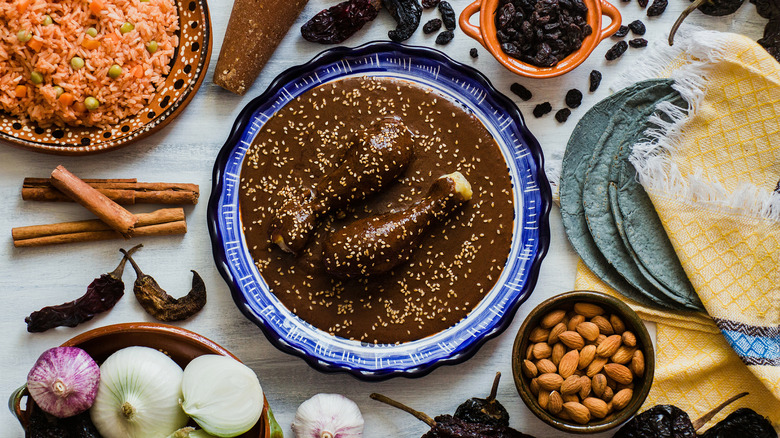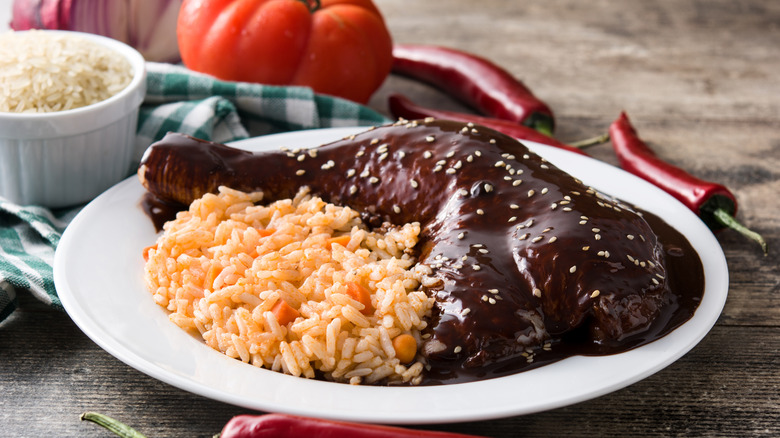Mole Poblano: The Traditional Dish That No Cinco De Mayo Is Complete Without
Wondering what mole poblano is? It's right there in the name! "mole" is derived from an Aztec word for "sauce," and "poblano" refers to a big, heart-shaped, dark green chili pepper that tastes fresh and mild. Admittedly, there is a bit more to the full recipe. Mole poblano utilizes dried poblanos, called ancho chilies, as well as cacao and sugar — or sometimes Mexican chocolate — to give it a sweet flavor and dark red-brown look. Other common additions include avocado leaf, garlic, nuts, onion, sesame seeds, and tortillas. Traditionally, mole poblano is used to coat turkey, either roasted or poached. Check out our mole poblano recipe for specific instructions on how to make your own.
Mole poblano is just one of many different moles — Mexican dishes that grind or purée chili peppers, dried spices, fruits, herbs, nuts, and seeds to create a thick sauce. They can taste hot, savory, sour, or sweet. Interestingly, mixtures such as guacamole or stews like mole de olla can also qualify as moles. Typically, however, a true mole refers to a creamy sauce that dresses meat and also sometimes burritos, enchiladas, or tacos. Nowadays, moles can easily be purchased at many restaurants and stores, making it simple to celebrate holidays like Cinco de Mayo with varieties such as mole poblano.
Where does mole poblano come from?
The people of the Aztec Empire primarily included chilies in their mole recipes. Peppers were ground into paste, which was mixed into a liquid and poured onto meat. Some narratives recount Aztecs serving conquistadors mole upon first meeting them. Other stories suggest chili mole was served as a royal and religious Aztec offering prior to contact with Europeans.
Modern moles in general come from the Mexican states of Oaxaca and Puebla. In colonial times, these regions were both melting pots for African, Asian, Indigenous, and European cuisines, which helped set the stage for moles to emerge as American fusion foods. Their first recipes were written down in the 19th century. Authentic mole is hand-made with a clay griddle called a dry comal, a stone mill called a metate, and a clay cooking pot called a cazuela. You don't need any of those to host the ultimate Cinco de Mayo fiesta, though.
Mole poblano, specifically, is rumored to have been invented at the Santa Rosa convent in Puebla by a nun during the 1600s. When an important local figure made a last-minute visit to that site, the nun in question used the ingredients she had on hand — almonds, garlic, onion, spices, tomatoes, peppers, and possibly cocoa — to whip up whatever she could. The details are sketchy, though, and this tale discounts the Aztec tradition that inspired moles. Still, tellingly, the dish is most famous in Puebla, where it's said to have been invented.
Why is the dish associated with Cinco de Mayo?
Mole poblano and Cinco de Mayo go hand in hand since they both call the state of Puebla home. Cinco de Mayo is also known as the Anniversary of the Battle of Puebla, a military conflict that occurred in Puebla de Zaragoza (the capital city of Puebla) circa 1862. One year prior, Mexico stopped paying back foreign debts, for a time, because of economic hardships. France then invaded to demand the money they were owed.
When the French marched on the city of Puebla, an underprepared force of Mexican soldiers managed to beat them back. Somewhere between 500 and 1,000 French troops died, while Mexico lost less than a hundred. The Franco-Mexican War continued for a handful more years, but this battle served as an inspiration, one that's still celebrated in that victorious region to this day.
The rest of Mexico does not pay the occasion as much attention, but Mexican immigrants in the United States started to popularize the holiday as a point of cultural pride during the middle of the 1900s. Some of the key features at such celebrations include folk dancing, mariachi music, parades, and a handful of authentic Mexican dishes perfect for Cinco de Mayo. Just like the Battle of Puebla, mole poblano is not to be forgotten.


